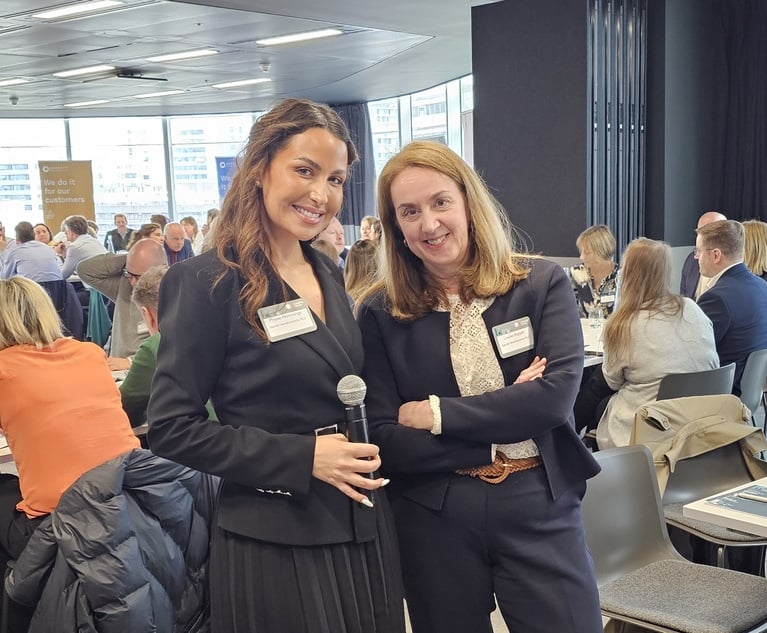Corporate Counsel: Getting stuck in
The inaugural Legal Week Corporate Counsel e-symposium witnessed calls for in-house lawyers to roll up their sleeves and muck in with their business colleagues. Michelle Madsen and Lauren Milner report
December 06, 2006 at 07:03 PM
8 minute read
Although many lawyers move in-house to take a step away from law firm culture and to become part of a business environment, in-house lawyers are still fighting to get the sort of commercial recognition that they deserve.
This was the one of the themes running through the inaugural Legal Week Corporate Counsel e-symposium, which was broadcast live online on 21 November.
Both keynote speakers at the virtual conference – Brackett Denniston and Peter Connor – highlighted the importance of business partnering for inhousers who wish to have an impact at a senior level.
Connor, who is general counsel for Europe, the Middle East and Africa at Citrix Systems, said business partnering – in which lawyers seek to provide business as well as legal advice – was an essential part of an in-house lawyer's role.
He said that because internal clients might not immediately seek to include their in-house counsel in business decisions, it was down to the lawyers to learn all they could about their companies and to think and talk like business executives.
"Talking in legalese is a sure way to turn off your clients," he said.
Denniston, general counsel of General Electric (GE), expressed similar sentiments when he outlined the model for running a successful global legal team.
He reinforced Connor's point that in-house lawyers had to be seen as business partners by their clients.
He said that as well as having a central function, the ideal in-house legal team should have lawyers embedded in the business units.
Denniston said it was vital to employ lawyers with general business skills. "We do not want 'rolodex lawyers'; by which I mean people who go out and just hire somebody else. We want doers, leaders and change agents – stars throughout our organisation."
He went on to stress the importance of recruitment to GE's goal of having a world-class legal team and identified the moment that the global giant started making partner-level lateral hires as a key landmark.
"My predecessor was instrumental in changing the way we hired people," he said. "The credo that we developed and the credo we have stayed with is 'hire the best' – we have broadened that to include all levels of our organisation."
This credo has seen GE expand significantly into China and Europe, hiring partners from local firms to head up teams at a regional level. He said GE's legal team in China had now grown to 40 lawyers.
"You need to be as good or better than a law firm", he said. "People are the fundamental building element of a good legal organisation. You cannot compromise."
People management
Getting the best out of the people was a key theme of the conference.
Eversheds head of employment Viv Du-Feu identified four distinct generational groups in the workplace: mature (62-plus), baby boomers (42-61), Generation X (27-41) and millennial (18-26).
He said the best companies recognised the distinct needs of these groupings.
"If you are a baby boomer and you measure things in your value set, you will be thinking about bonuses, cash and rewards. If you are trying to recruit someone from Generation X [27-40] or a millennial [18-26] you might think about converting that into an extra week's holiday or a gym membership – things that have more interest or more relevance to that group."
He added: "Loyalty and satisfaction are measurements of an emotional connection between people and something about their work. The younger the person, the more the emotional connection comes via the person's relationship with their leader. Older employees tend to have more loyalty to the company than the individual."
Isabelle Deschamps, head of legal and company secretary of Nestle, said: "Ten years ago we were all working in very flat structures, with one boss for a large number of people. We have to ask ourselves: 'Is this model still working with a younger generation who want to connect with their leader very quickly?'"
Given the recent legislation brought in with the new Age Discrimination Act, generational issues are a hot topic. As Legal Week reported in October, the City's top law firms rushed to make 11th-hour changes to their governance structures in order to comply with the new regime.
Addleshaw Goddard employment partner Jane Amphlett warned that the legislation would expose companies to claims from a new group she identified as "pale, stale males" who have historically had no footing on which to make discrimination claims.
She warned employers not to fall victim to complacency.
"People do not see that there is a problem using age-old language like 'young whippersnapper' or 'grey hair', or sending birthday cards that refer to people being over the hill. These are practices that people just do not see as harmful."
Samantha Mercer, director of the Employers Forum on Age, added: "Racism and sexism are a bit like drink-driving in that no-one will admit to it. Ageism is a bit like speeding in that everybody does it but no-one thinks it is particularly harmful".
The panel agreed that there was a danger that alarmist stories in the press concerning the location of Christmas parties or the banning of birthday cards could undermine the new regime.
Michael Barratt, a senior solicitor in Friends Provident's employment and litigation group, said: "There are lots of things that were socially acceptable 20 years ago – my first office was smoke-filled, now one would not dream of smoking in the office. Things move on, and people will start to under-stand why."
Relationship building
Communication, both internally between legal and other departments and externally, was another key conference theme.
Historically, UK in-house lawyers have been regarded by clients and the wider legal profession as being stand-offish and have gained a subsequent reputation for being less proactive on the communication front than their US counterparts.
Jack Naylor, head of UK litigation at PricewaterhouseCoopers (PwC) said the influence of his firm's in-house lawyers hinged on their ability to act as problem solvers.
"It is crucial that any lawyer at PwC is seen as a problem solver. The moment internal lawyers are viewed as an obstacle their value dissipates."
Mirza Ahmad, chief legal officer at Birmingham City Council, said in the public sector the big challenge was to make people comfortable with receiving advice from lawyers.
He said lawyers needed to be involved in the decision-making process at the earliest possible stage. "We are not obstacles – we are very much corporate team players," he said.
Tom Ellis, a dispute resolution partner at Bevan Brittan, said it was essential for in-house lawyers to move away from being too closely associated with risk management to taking on a wider advisory role.
He added: "General counsel are seen as being in a stable position and people turn to them for advice. Taking on a broader role would be welcomed."
The panel debated whether lawyers should be embedded within business units or sit together in a central function.
Andrew Napier, head of legal at the British Red Cross, said: "We have people operating all over the world and we see it as vital to get out and spread ourselves around. We do not just want to be seen as a central function in London in our ivory tower."
He identified emails as the biggest barrier to effective communication for the in-house lawyer. He added: "Emails are the greatest obstacle to building relationships with individuals. Sending someone an email which may or may not be intelligible, as opposed to picking up the phone or going over to see them, is the greatest curse of any in-house lawyer."
The panel agreed that there was no substitute for face-to-face contact with clients. Relationships between in-house lawyers and outside counsel also came under scrutiny. Catherine McKenna, head of pensions at Hammonds, drew on the Legal Week Intelligence FTSE/AIM Client Satisfaction Survey, which found that most law firms satisfy client expectations over the quality of their advice but fall short when it comes to relation-ship management.
She said: "Clients look at sector expertise, reputation, cost and previous experience when seeking outside counsel. What value for money the law firms provide is a key question in a market which has shown an increasing trend towards reducing costs and legal spend."
According to McKenna, a relationship between in-house lawyers and outside counsel should be: "Not a marriage or a one-night stand, but a long-term partner-ship." She also stressed the importance of soft skills to encourage an atmosphere of trust, respect and equality.
Claire Vaughan, European legal director at Smith & Nephew, said that outside counsel should be looked upon as trusted advisers by their corporate counterparts, just as in-house lawyers themselves are seen as trusted advisers by their clients.
She added: "It is absolutely vital that [in-house counsel] are proactive and spend as much time investing in relationships with smaller firms as with the firms who do the bulk of our work."
Archived presentations and discussions can be accessed online at www.legalweek. e-symposium.com.
This content has been archived. It is available through our partners, LexisNexis® and Bloomberg Law.
To view this content, please continue to their sites.
Not a Lexis Subscriber?
Subscribe Now
Not a Bloomberg Law Subscriber?
Subscribe Now
NOT FOR REPRINT
© 2025 ALM Global, LLC, All Rights Reserved. Request academic re-use from www.copyright.com. All other uses, submit a request to [email protected]. For more information visit Asset & Logo Licensing.
You Might Like
View All
Broadcom Hires From Nuclear Giant to Appoint French Legal Head

GCs Say They are Getting 'Edged Out' of UK Boardrooms

'I Won’t Name the Firm, But...'—Barratt Redrow's Legal Head on External Counsel Red Flags
Trending Stories
- 1To Speed Criminal Discovery, NY Bill Proposes Police-to-Prosecutor Pipeline For Records
- 2Merchan Rejects Trump's Bid to Delay Manhattan Sentencing
- 3High-Low Settlement Agreement 'Does Not Alone Establish Bias:' State High Court Affirms $20M Med Mal Verdict
- 4NYAG Preparing to Withdraw From Defense of Four Correction Officers' Federal Lawsuits
- 52 Judges: Meet the New Chief Justice and the GC Who Just Rose to the Bench
Who Got The Work
Michael G. Bongiorno, Andrew Scott Dulberg and Elizabeth E. Driscoll from Wilmer Cutler Pickering Hale and Dorr have stepped in to represent Symbotic Inc., an A.I.-enabled technology platform that focuses on increasing supply chain efficiency, and other defendants in a pending shareholder derivative lawsuit. The case, filed Oct. 2 in Massachusetts District Court by the Brown Law Firm on behalf of Stephen Austen, accuses certain officers and directors of misleading investors in regard to Symbotic's potential for margin growth by failing to disclose that the company was not equipped to timely deploy its systems or manage expenses through project delays. The case, assigned to U.S. District Judge Nathaniel M. Gorton, is 1:24-cv-12522, Austen v. Cohen et al.
Who Got The Work
Edmund Polubinski and Marie Killmond of Davis Polk & Wardwell have entered appearances for data platform software development company MongoDB and other defendants in a pending shareholder derivative lawsuit. The action, filed Oct. 7 in New York Southern District Court by the Brown Law Firm, accuses the company's directors and/or officers of falsely expressing confidence in the company’s restructuring of its sales incentive plan and downplaying the severity of decreases in its upfront commitments. The case is 1:24-cv-07594, Roy v. Ittycheria et al.
Who Got The Work
Amy O. Bruchs and Kurt F. Ellison of Michael Best & Friedrich have entered appearances for Epic Systems Corp. in a pending employment discrimination lawsuit. The suit was filed Sept. 7 in Wisconsin Western District Court by Levine Eisberner LLC and Siri & Glimstad on behalf of a project manager who claims that he was wrongfully terminated after applying for a religious exemption to the defendant's COVID-19 vaccine mandate. The case, assigned to U.S. Magistrate Judge Anita Marie Boor, is 3:24-cv-00630, Secker, Nathan v. Epic Systems Corporation.
Who Got The Work
David X. Sullivan, Thomas J. Finn and Gregory A. Hall from McCarter & English have entered appearances for Sunrun Installation Services in a pending civil rights lawsuit. The complaint was filed Sept. 4 in Connecticut District Court by attorney Robert M. Berke on behalf of former employee George Edward Steins, who was arrested and charged with employing an unregistered home improvement salesperson. The complaint alleges that had Sunrun informed the Connecticut Department of Consumer Protection that the plaintiff's employment had ended in 2017 and that he no longer held Sunrun's home improvement contractor license, he would not have been hit with charges, which were dismissed in May 2024. The case, assigned to U.S. District Judge Jeffrey A. Meyer, is 3:24-cv-01423, Steins v. Sunrun, Inc. et al.
Who Got The Work
Greenberg Traurig shareholder Joshua L. Raskin has entered an appearance for boohoo.com UK Ltd. in a pending patent infringement lawsuit. The suit, filed Sept. 3 in Texas Eastern District Court by Rozier Hardt McDonough on behalf of Alto Dynamics, asserts five patents related to an online shopping platform. The case, assigned to U.S. District Judge Rodney Gilstrap, is 2:24-cv-00719, Alto Dynamics, LLC v. boohoo.com UK Limited.
Featured Firms
Law Offices of Gary Martin Hays & Associates, P.C.
(470) 294-1674
Law Offices of Mark E. Salomone
(857) 444-6468
Smith & Hassler
(713) 739-1250







